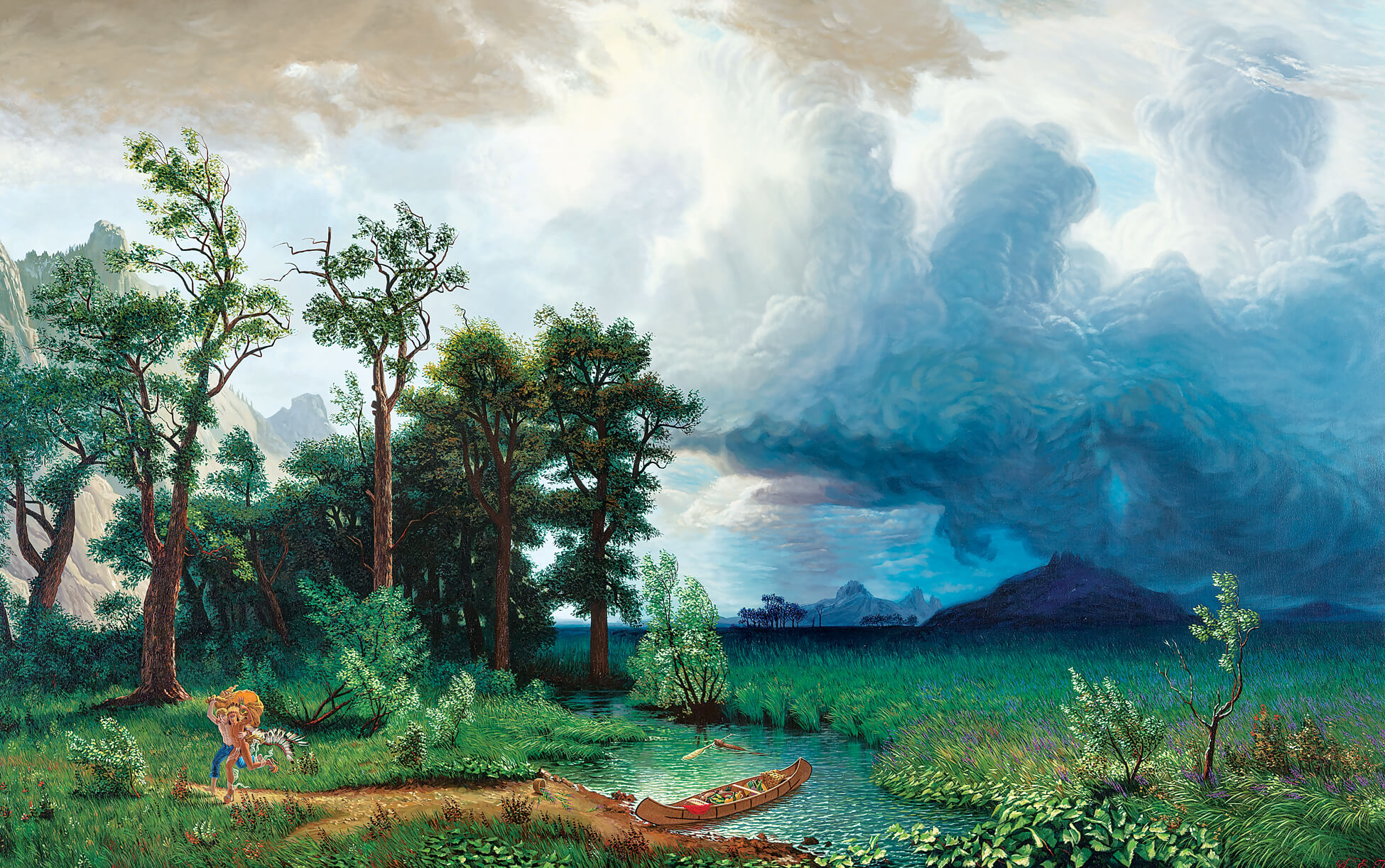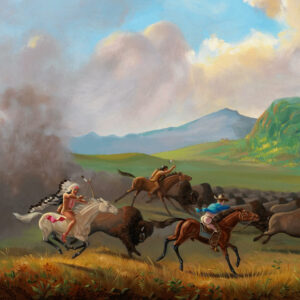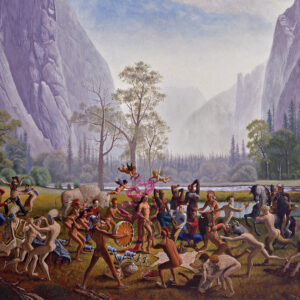The Impending Storm 2004

Kent Monkman, The Impending Storm, from The Trilogy of Saint Thomas, 2004
Acrylic on canvas, 152.6 x 242.4 cm
Montreal Museum of Fine Arts
In The Impending Storm, Kent Monkman tells of a mythological tragic romance between Miss Chief Eagle Testickle and her Orangeman lover, the young Thomas Scott. We see two figures—Miss Chief and Scott—fleeing together from a dark, ominous cloud hovering over a landscape inspired by the monumental works of American painter Albert Bierstadt (1830–1902). The painting is part of a series that Monkman refers to interchangeably as The Moral Landscape or Eros and Empire, and it is the first in a three-part narrative titled The Trilogy of Saint Thomas, 2004.
The Impending Storm offers a fictional narrative about the story of Scott, who was an Irish Protestant who moved to the Red River Colony (now part of Manitoba) in 1869. The following year, Scott was convicted of treason and executed by the provisional government, led by Métis leader Louis Riel, on March 4. The event led to the Red River Expedition, in which Prime Minister John A. Macdonald sent a military force to the colony to confront the Métis at Red River.
The storm is used as an allegory for an ending of innocence and the suggestion of impending doom, as if representing the threats that were about to encroach on Indigenous existence following the events in Red River. Rather than portraying conflict or rivalry, Monkman decided to use the paintings as a vehicle for reconciliation through a love story. The tale is conceived as a metaphor for the entwined histories and relationships between white settlers and Indigenous peoples.1
-
Kent Monkman, The Fourth of March, from The Trilogy of Saint Thomas, 2004
Acrylic on canvas, 183.4 x 274.8 cm
Montreal Museum of Fine Arts -
Kent Monkman, The Fourth of March (detail), from The Trilogy of Saint Thomas, 2004
Acrylic on canvas, 183.4 x 274.8 cm
Montreal Museum of Fine Arts -
Kent Monkman, Not the End of the Trail, from The Trilogy of Saint Thomas, 2004
Acrylic on canvas, 183.7 x 274.7 cm
Montreal Museum of Fine Arts
-
Kent Monkman, Not the End of the Trail (detail), from The Trilogy of Saint Thomas, 2004
Acrylic on canvas, 183.7 x 274.7 cm
Montreal Museum of Fine Arts
By adapting the conventions of nineteenth-century artworks and by fusing fact and fiction, Monkman projects his own stories upon landscapes that are sites of contact and contention.2 Historically, Indigenous peoples were represented as insignificant or minute in comparison to the landscape, if they were depicted at all. In this work, the couple flees the gathering storm, a natural event often depicted in Romantic paintings as evidence of the environment’s power over humans and a metaphor for the threat that the untamed wilderness faces from human activity.
Completing the trilogy are The Fourth of March, 2004, and Not the End of the Trail, 2004. The former references Scott’s execution, an event that had a significant political impact on what was to come for the Cree people. His death in 1870 led the Canadian government to send forces to Manitoba, which became a new province that same year, and once it had joined Confederation, federal oppression of Indigenous peoples intensified. In the final painting, Miss Chief buries her lover. She is depicted very much alone on her horse, an allusion to the colonizers’ desire to view Indigenous peoples as “a disappearing race.” The imagery of Miss Chief in this composition is a deliberate echo of the sculpture End of the Trail, 1918, by James Earle Fraser (1876–1953), which casts Indigenous people as being on the cusp of tragically vanishing from the world.

 About the Author
About the Author
 More Online Art Books
More Online Art Books
 Acknowledgements
Acknowledgements